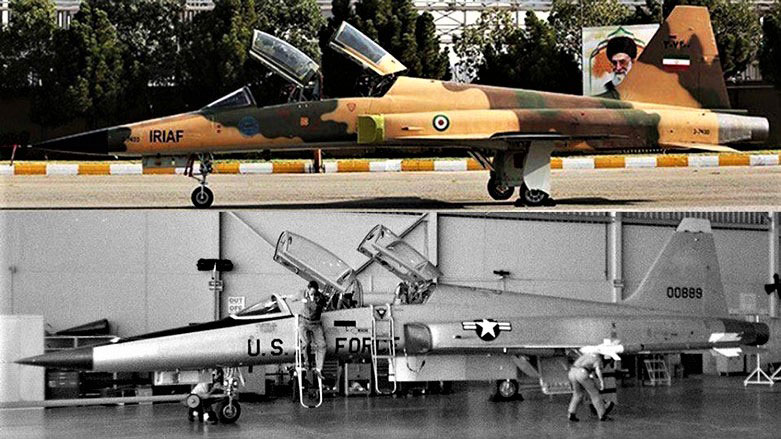Iran claims its ‘Kowsar’ fighter jet not just copy of antiquated US plane
Iran insists that the newly-unveiled fighter jet dubbed the “Kowsar” is completely homegrown, though military experts point out its striking similarities to the US-made Northrop F-5s, sold to Tehran in the 1960s and 1970s during the reign of Mohammad Reza Shah.

ERBIL (Kurdistan 24) – Iran insists that the newly-unveiled fighter jet dubbed the “Kowsar” is completely homegrown, though military experts point out its striking similarities to the US-made Northrop F-5s, sold to Tehran in the 1960s and 70s during the reign of Mohammad Reza Shah.
“The first advanced fighter jet which is equipped with Avionics and advanced fire control of the native 4th generation, called Kowsar, has been produced with local supplies domestically,” media outlets with close ties to Tehran quickly pointed out during the new model's unveiling ceremony on Tuesday.
On the same day, Director of the Armed Forces Aircraft Industry Organization, Brigadier General Abdul-Karim, confidently stated that the fighter was “100 percent native and domestically-produced.”
The Islamic Republic President Hassan Rouhani marked National Defence Industry Day in Tehran and was present as the Kowsar made its debut in a dramatic fly-by.
Various individuals, however, quickly pointed to the fighter jet's uncanny resemblance to the F-5, which made its first flight nearly 60 years ago, in 1959.
“It seems that the regime’s officials are not sufficiently familiar with the evolution of the aviation industry. Their planes are very much like a fighter produced by United States decades ago; of which Iran bought. But deception is their favorite method," the Communications Team of the Department of State tweeted.
كشف #النظام_الإيراني عن طائرة مقاتلة "جديدة" قال انها "متطورة" وانها "صناعة محلية".
— فريق التواصل DOS (@DOTArabic) August 21, 2018
يبدو ان مسؤولي النظام ليسوا على دراية كافية بمدى تطور صناعة الطيران. فطائرتهم تشبه الى حد كبير مقاتلة انتجتها #الولايات_المتحدة قبل عقود، ولدى #إيران اسطول قديم منها. لكن الخداع هي وسيلتهم المفضلة pic.twitter.com/OW5jDb1f5j
Israeli Defense Minister Avigdor Lieberman told al-Arabiya that “the US sanctions are putting a lot of pressure on the country, and for this reason, they are telling fairy tales. At the same time, it's best not to underestimate their activities.”
Highlighting the visual likeness of the two planes, Research Associate for Defence and Military Analysis at the International Institute for Strategic Studies (IISS) Joseph H. Dempsey also posted a tweet with pictures of both jets to show how the two, at least in outward structure, appear close to identical.
#Iran 'Kowsar' indigenous fighter - prototype 3-7400 (2018)#US Northrop F-5F Tiger II combat capable trainer - prototype 00889 (1974) pic.twitter.com/b8vJ7qGd9n
— Joseph Dempsey (@JosephHDempsey) August 21, 2018
Douglas Barrie, also of the IISS, speaking to CNBC on Wednesday, said that Tehran's claims should be taken with “a massive pinch of salt” adding that “the Iranians probably have the industrial capacity to at least make fuselage assemblies for this aircraft. They have obviously been able to make bits of these things.”
“The fighter is very similar to the US F-5 fighter, or if we want to say better, Kowsar is in fact a heightened upgrade of the F-5's plan, which is being developed by the Defense Ministry,” wrote Tasnim on Thursday, speaking on behalf of the Islamic Republic Guards Corps (IRGS).
The Iranian outlet added, “Our country's experts have been able to turn the F-5 fighter into a more modern fighter, and today it can be said that Iran has a modern standard for F-5s,” and listed specifications such as a new turbojet engine which gives it the ability to fly at elevations of up to 50,000 feet.
The antiquated analog system of targeting was converted to a digital one, the article continued, and pointed out that the F-5 did not have infrared and radar targeting systems, as the new one does.
Ten universities, 72 contractor companies, 44 insurance companies, and 63 research and development companies are said to have contributed to the project.
“Apart from the American F-5 body design, today there is nothing else in the fighter belonging to them. That is, the only thing that has not changed is the design of the F-5 fighter,” the report concluded.
During the era of the Shah, Iran bought over 300 F-5 fighter jets from the United States, many of which were lost during the Iran-Iraq war in the 1980s.
The F-5 is still used by military forces of several countries, but often only for pilot training.
Editing by John J. Catherine
